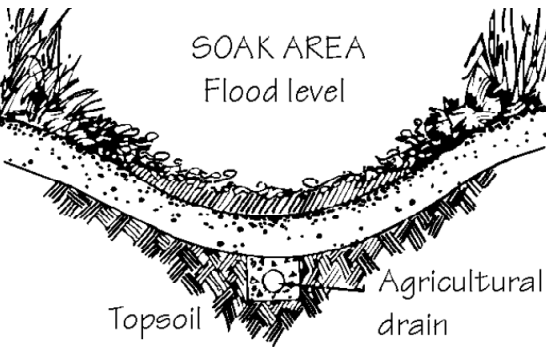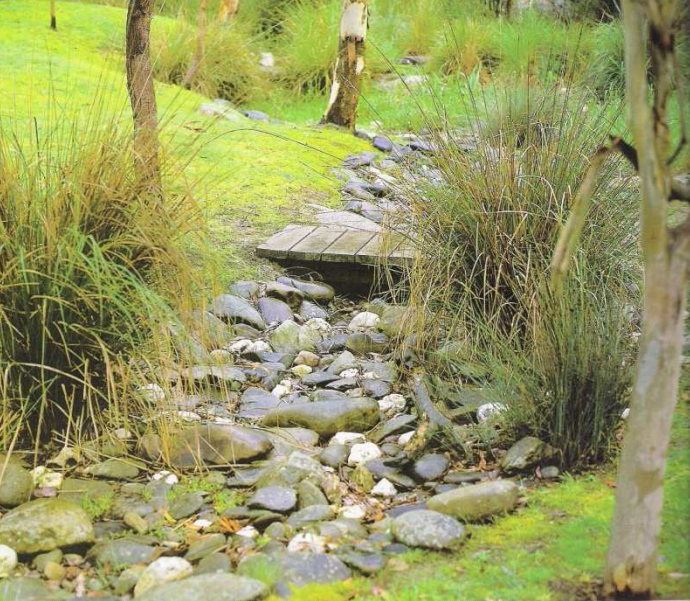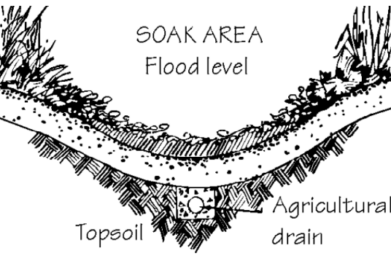Australia is often called the “driest country” and yet we may not recognise that we are also higher users of water, per capita, than the people of many other countries. Water storage shortages in our capital cities and therefore water restrictions are forcing gardeners to adopt water saving practices in our gardens. The time has come for us to make gardens that respond to the true nature of Australia’s climate.
Basically, a water-wise approach includes the view of household and gardens as one system of water supply and efficient water use. Inputs can include mains water, rainwater capture and storage in tanks, and stormwater control, manipulation or storage. On the output side we need strategies to recycle and reduce water use.
A water sensitive dwelling and a water-wise garden are designed and used so as to minimise harmful impacts on the natural water cycle. By incorporating water sensitive measures in the design of new homes and the renovation of existing homes and gardens, it is possible to help:
- Reduce flood risk in urban areas
- Prevent erosion of waterways, slopes and banks
- Improve water quality in streams and groundwater
- Make more efficient use of water resources
- Reduce the cost of providing and maintaining water infrastructure
- Protect and restore aquatic and riparian ecosystems and habitats
- Protect the scenic, landscape and recreational values of streams
(WSUD, ‘Water Sensitive Homes’, Practice Note 1)
Of course, there are also good economic reasons for reducing water use in our homes and gardens. It is estimated that between one-quarter and one-third of all domestic water use is for gardens. The potential for reducing this amount and your water bill is a great incentive to adopt water-wise gardening.
Kevin Walsh (author of the popular book Waterwise Gardening) suggests there are six vital principles to help save water:
- Reduce the area of lawn
- Group plants according to their water needs
- Use drought-tolerant plants
- Maintain the garden
- Use mulch
- Water efficiently
“Most Australian gardens are not designed with water use in mind” (p.11) “Indigenous native plants are those that grow and reproduce naturally in the area in which you live. Because these plants have developed over millennia to suit the climate, soils and other conditions of the area, they are uniquely adapted and often survive where many other plants fail. By growing indigenous plants you are making a waterwise choice for your garden and helping to preserve the biodiversity of your local area” (p. 55)
Kevin Walsh, Waterwise Gardening, 2003
Managing stormwater runoff
A wide variety of landscape measures can be used to manage stormwater flows, utilise stormwater within the site, and minimise supplementary watering of landscaping. The careful design and placement of landscape measures can have many benefits for the water cycle, including reduced peak stormwater discharges, increased groundwater recharge, reduced erosion and sedimentation, increased retention of soil moisture and lower water costs. This is in addition to likely aesthetic and ecological benefits.
A variety of landscape measures for managing stormwater may include:
- Rrock or gravel basins
- Vegetated filter strips
- Contour banks
- Soak or bog areas
- Wind and sun protection
- Plant selection
- Minimising lawn
- Efficient irrigation
Swales and contour banks
You can create shallow depression drains and small banks of soil (called swales and contour banks) to direct water to or away from specific groups of plants. Group plants according to their water needs – with thirster plants placed along swales.
(Paul Urquhart, The New Native Garden; Designing with Australian Plants, p.197)
Aim to create a diverse system within the landscape that is not reliant on a single device to manage stormwater. This will allow other parts of the landscape to adequately deal with stormwater flows in the event of failure or exceedance of design capacity. For example, a gravel-lined pond collects overflow from a water tank – spills over to a turfed filter strip – drains gently to a series of drainage swales spot-planted with species that tolerate temporarily saturated soil – drains to a soak area … and so on! This interconnecting system collects flow at a point source, reduces its speed and allows it to progressively infiltrate the soil, thereby reducing the risk of erosion, sedimentation and flooding.

Rock, stone or gravel can be used to line stormwater basins or channels. This can act to slow the rate of flow, dissipate energy and prevent surface erosion. It is a particularly useful method for managing concentrated stormwater discharges due to topography or from adjoining properties, stormwater easements, downpipes or water tank overflow pipes.
The size and composition of rocks or boulders must remain in proportion to the scale and style of the project and the site. Larger sites can accommodate larger features and unit materials without being overwhelmed, although it is possible to contain some large elements within a smaller area provided that it is cohesively designed.
Large pebbles or deep beds of gravel can be used to complement landscape themes. They can be used as an alternative to organic mulches for preventing soil moisture loss. Obtain rock from on-site excavation works, other local construction sites or a local quarry. Avoid using blue metal as runoff from it will alter the soil pH. (WSUD, ‘Landscape Measures’ Practice Note 7’)

Organic mulches, stone and gravel
There are a wide range of mulches available for use in gardens. The more common mulches include:
- Compost
- Pea straw
- Hay
- Sugar cane mulch
- Fine pine bark
- Woodchips
- Eucalyptus forest mulch
- Fibre matting (for steep slopes)
- Stone, pebbles & gravel (particularly useful in bushfire prone areas)
- Recycled newspaper & cardboard
Mulching has many benefits to plant health and water conservation. As well as reducing evaporation, it suppresses weed germination and growth (by reducing light penetration to the soil surface) and stabilises soil temperature (beneficial to root development and soil organisms). Organic mulch slowly breaks down to supply soil nutrients.
Use the following guidelines to help ensure efficient water use and good plant growth.
- Apply 75-100 mm of organic mulch over the surface as a blanket on massed plantings. Top up annually. Keep mulch at least 150 mm away from trunks and stems to prevent rot.
- Use a mixture of textures to allow water to pass through. A combination of chipped bark and leaves decomposes at different rates and supplies a variety of minerals and nutrients.
- Avoid introducing pests and diseases from mulch imported to the site. Obtain materials that satisfy Australian Standard AS 4454 Composts, Soil Conditioners and Mulches, or current standard.
- Do not apply fresh organic products directly to the soil (such as sawdust, woodchips and pinebark). These materials extract soil nitrogen (‘nitrogen drawdown’), competing with plant uptake and causing sickly plants.
- Add fertiliser (manure or blood and bone) before application, or compost the material before use.
- Inorganic mulch can be used, but does not add humus and nutrients to the soil. Use crushed rock, gravel and brick, silicon chip, coarse river sand, scoria or river pebbles to complement landscape themes or where loose materials may be blown away. Avoid blue metal as this can alter soil pH. Use to a depth of about 50 mm to allow water penetration.
- Mulch matting can be used on slopes where other mulches may slip. When pegged in position, the mat forms a stable surface whilst trees, shrubs and groundcovers establish. Plants can be pocket planted through the matting. Use 100% organic matting, such as jute. The matting must not contain inorganic fibre such as nylon.
- If using an irrigation system, install an underground or surface drip system to make sure the water reaches the soil below the mulch.
- Avoid using mulch in areas where it is likely to be washed away by surface flow during heavy rain. (WSUD, ‘Landscape Practices’ Practice Note 8’; see also Walsh, Waterwise Gardening, pp 122-135)
References and further reading
- Paul Urquhart, (1999), The New Native Garden: Designing with Australian Plants, New Holland Publishers, Sydney, NSW
- Kevin Walsh, (2004), Waterwise Gardening, New Holland Publishers, Sydney NSW
- Allan Windust, (2003), Waterwise house and garden: a guide for sustainable living, Landlinks Press, Collingwood, Vic.


